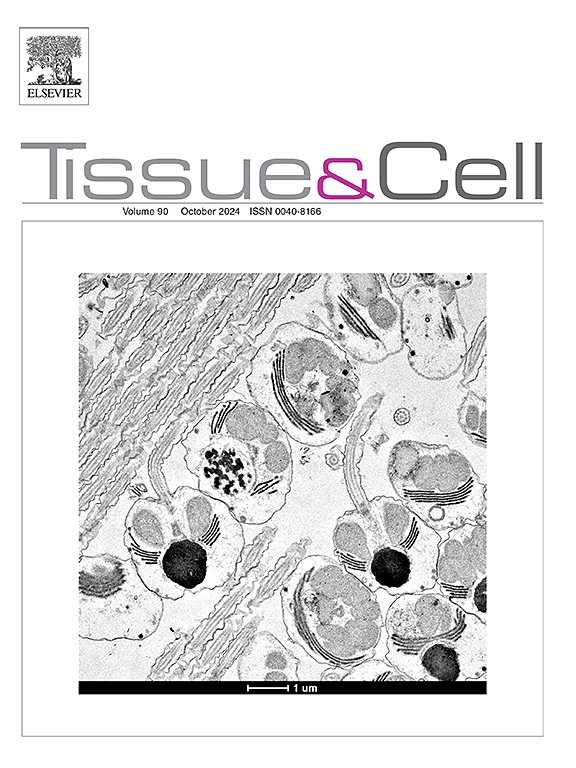RRS1在皮肤鳞状细胞癌中的作用及功能研究
IF 2.7
4区 生物学
Q1 ANATOMY & MORPHOLOGY
引用次数: 0
摘要
RRS1(核糖体合成调节因子1)已被确定为某些癌细胞增殖、转移和侵袭的关键因子。在这项研究中,免疫组织化学分析和GEO数据库研究表明,与正常皮肤相比,rs1在皮肤鳞状细胞癌(cSCC)组织和颈部鳞状细胞癌(HNSCC)中的表达明显更高。为了进一步研究RRS1的作用,我们采用慢病毒转导方法在A431细胞中建立了RRS1敲低模型。RRS1敲除后,MTT、Celigo划痕和Transwell实验显示A431细胞增殖、转移和侵袭性显著降低。qRT-PCR基因表达分析发现,与这些细胞过程相关的基因发生了显著变化,而转录组测序显示,在RRS1敲除后,蛋白激酶C δ (PRKCD)、丝裂原活化蛋白激酶3(MAPK3)、瞬时受体电位阳离子通道亚家族V成员4(TRPV4)、锚蛋白1(ANK1)和磷脂酶A2组VI(PLA2G6)这五个关键基因的表达显著降低。这些发现表明,RRS1在促进cSCC肿瘤细胞生长和传播中起着至关重要的作用,并突出了其作为一种新的治疗靶点的潜力。本文章由计算机程序翻译,如有差异,请以英文原文为准。
Study on the role and function of RRS1 in cutaneous squamous cell carcinoma
RRS1 (regulator of ribosome synthesis 1) has been identified as a critical factor in the proliferation, metastasis, and invasion of some cancer’s cells. In this study, immunohistochemical analysis and GEO database studies demonstrated significantly higher RRS1 expression in cutaneous squamous cell carcinoma(cSCC) tissues and neck squamous cell carcinoma (HNSCC) compared to normal skin. To further investigate RRS1's role, a lentiviral transduction method was used to establish an RRS1 knockdown model in A431 cells. Following RRS1 knockdown, MTT, Celigo scratch, and Transwell assays revealed a significant reduction in A431 cell proliferation, metastasis, and invasiveness. Gene expression analysis by qRT-PCR identified notable changes in genes related to these cellular processes, while transcriptome sequencing highlighted five key genes—protein kinase C delta(PRKCD), mitogen-activated protein kinase 3(MAPK3), transient receptor potential cation channel subfamily V member 4(TRPV4), ankyrin 1(ANK1), and phospholipase A2 group VI(PLA2G6)—showing significantly reduced expression after RRS1 knockdown. These findings suggest that RRS1 plays a crucial role in promoting cSCC tumor cell growth and dissemination and highlight its potential as a novel therapeutic target.
求助全文
通过发布文献求助,成功后即可免费获取论文全文。
去求助
来源期刊

Tissue & cell
医学-解剖学与形态学
CiteScore
3.90
自引率
0.00%
发文量
234
期刊介绍:
Tissue and Cell is devoted to original research on the organization of cells, subcellular and extracellular components at all levels, including the grouping and interrelations of cells in tissues and organs. The journal encourages submission of ultrastructural studies that provide novel insights into structure, function and physiology of cells and tissues, in health and disease. Bioengineering and stem cells studies focused on the description of morphological and/or histological data are also welcomed.
Studies investigating the effect of compounds and/or substances on structure of cells and tissues are generally outside the scope of this journal. For consideration, studies should contain a clear rationale on the use of (a) given substance(s), have a compelling morphological and structural focus and present novel incremental findings from previous literature.
 求助内容:
求助内容: 应助结果提醒方式:
应助结果提醒方式:


